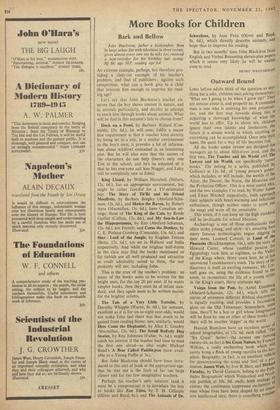More Books for Children
Bark and Bellow
John Blackston; father a bookmaker; lives in large urban flat with television in three rooms; given almost every new toy he asks for; received a tape-recorder for his birthday last spring; IQ 86; age 10.7; reading age 6.4
AN extreme example, perhaps, but therefore pro- viding a clear-cut example of his teacher's problem, and that of publishers: against such competition, what can a book give to a child that interests him enough to improve his read- ing age?
Let's say that John Blackston's teacher ob- serves that the boy shows interest in nature, and in animals particularly, and decides to attempt to reach him through books about animals. What will he find in this autumn's lists to choose from?
Duck on a Pond, by Barbara Willard (Con- stable, 13s. 6d.), he will note, fulfils a major first requirement in that it touches John directly by being set in a city, in a similar environment to the boy's own; it provides a lot of informa- tion about wildfowl embodied in an interesting plot. But he will also note that the names of the characters do not help (there's only one Tim in the school, and he's so ashamed of it that he has everyone call him Nogger, and Letty will be completely new to John).
King Lizard, by William Herschel! (Nelson, 12s. 6d.), has an appropriate environment, but might be rather fanciful for a TV-orientated boy. The Story of Tit'lle and his Friend Mouffette, by Barbara Bingley (Abelard-Schu- man, 12s. 6d.), and Sketco the Raven, by Robert Ayre (Macmillan, 13s. 6d.), have Canadian set- tings; those of The King of the Cats, by Renee Guillot (Collins, 12s. 6d.), and My Son-in-Law the Hippopotamus, by Ezo (Abelard-Schuman, 12s. 6d.), are French; and Corso the Donkey, by C. E. Pothast-Gimberg (Constable, I3s. 6d.), and Sher : Lord of the Jungle, by Eugenie Fenton (Senn, 12s. 6d.), are set in Holland and India respectively. And while the brighter half-dozen in the class may find the books mentioned so far (which are all well produced and attractive to read) admirably suited to them, the rest probably will not, including John.
This is the crux of the teacher's problem : so many of the books seem to be written for the bright ones, for the top 20 per cent. If he wants simpler books, then they must be of infant stan- dard; and they again seem to be written mainly for the brighter infants.
The Tale of a Very Little Tortoise, by Dorothy Whipple (Warne, 8s. 6d.), for instance, excellent as it is for six-to-eight-year-olds, would not make John feel there was that much to be gained from reading better; nor, similarly, would Here Come the Elephants!, by Alice E. Goudey (Macmillan, 12s. 6d.). The Scruff Rafferty Dog Stories, by Roy Johnston (Faber, 9s. 6d.), might catch his interest if the teacher had time to read the first one aloud—as also might Michael Bond's A Bear Called Paddington (now avail- able as a Young Puffin at 3s.).
But John Blackston should have been intro- duced to this sort of book at the appropriate age: that he was not is the fault of far too large classes and far too few imaginative teachers.
Perhaps his teacher's only solution (and it must be a compromise) is to introduce the boy to books like Zoo Tales, by T. H. Gillespie (Oliver and Boyd, 6s.), and The Animals of Dr. Schweitzer, by Jean Fritz (Oliver and Boyd, 8s. 6d.), which directly describe animals, and hope thus to improve his reading.
But in two months' time John Blackston faces English and Verbal Reasoning eleven-plus papers which it seems very likely he will be unable even to read.
HENRY WR1OTHESLEY










































































 Previous page
Previous page